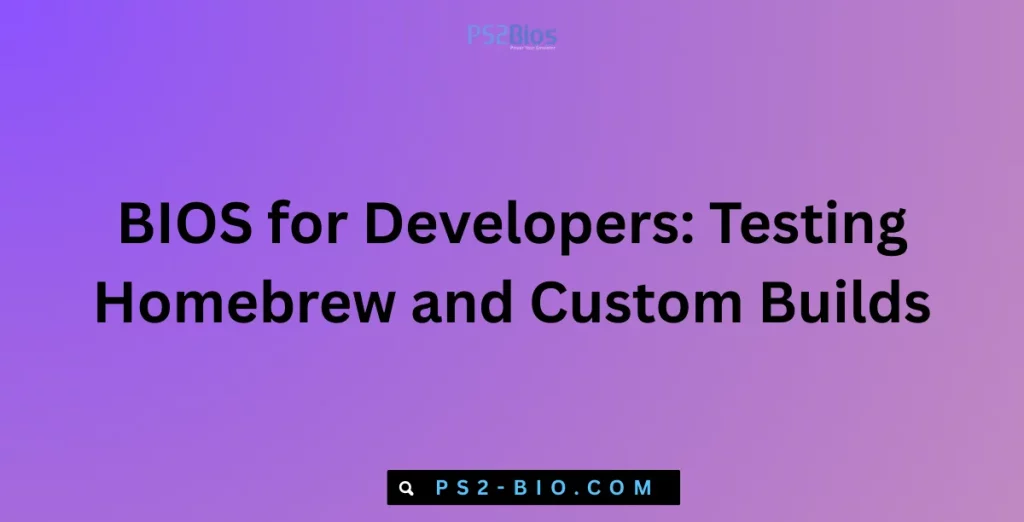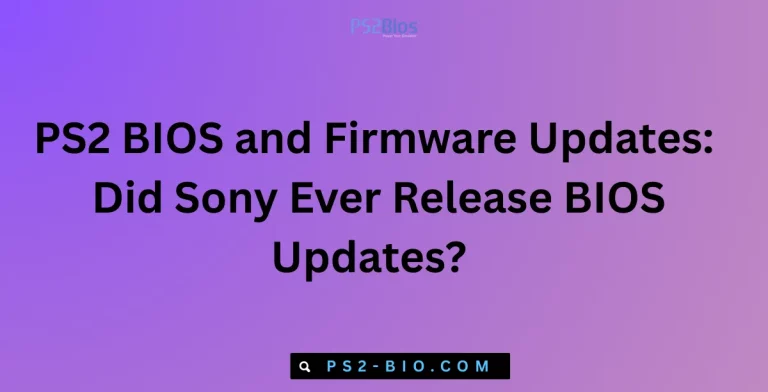BIOS for Developers: Testing Homebrew and Custom Builds
Ever wondered how developers test homebrew applications and custom builds on consoles or emulators? The answer often lies in using the system BIOS as a foundation.

What Is BIOS in Development?
The BIOS (Basic Input/Output System) is the firmware that initializes hardware and provides essential functions before an operating system starts. In console and embedded development, it plays a critical role in testing homebrew software, custom firmware, and experimental builds.
Developers rely on BIOS files to recreate authentic hardware conditions in emulators like PCSX2 (PlayStation 2), Dolphin (GameCube/Wii), and PPSSPP (PlayStation Portable). Without the BIOS, the system cannot properly load or execute low-level code, making it impossible to test new builds accurately.
Why Developers Use BIOS for Homebrew Testing
Testing homebrew and custom builds requires replicating hardware behavior. BIOS files ensure this process is precise by handling device initialization, memory checks, and input/output management. Below are the main reasons developers depend on BIOS:
- Hardware Accuracy – Provides the same boot-up sequence as real hardware.
- Debugging Support – Helps identify low-level issues in code execution.
- Compatibility Testing – Ensures that homebrew software functions across different BIOS versions.
- Performance Evaluation – Measures how a custom build behaves under near-original conditions.
For example, the PlayStation 2 BIOS enables PCSX2 developers to test fan-made builds and patches with authentic console behavior, ensuring stability before release.
Legal Aspects Developers Must Know
A critical point: BIOS files are copyrighted. Developers cannot legally download or distribute them. To remain compliant:
- Dump the BIOS from your own console or device – Tools like
BIOS Dumperfor PS2 orGC BIOS Dumperfor GameCube extract the file legally. - Avoid unofficial sources – Downloading BIOS files from the internet violates copyright law.
- Check developer licenses – Some open-source projects, such as FreeBIOS or Coreboot, allow legal usage for testing custom builds.
According to the U.S. Digital Millennium Copyright Act (DMCA), sharing or distributing BIOS images without authorization is a violation of intellectual property law (U.S. Copyright Office). Developers must only use BIOS obtained from devices they own.
Setting Up BIOS for Testing Homebrew
The setup process varies depending on the platform, but the general steps are:
- Dump the BIOS legally using console-specific tools.
- Place the BIOS file in the correct directory of the emulator or development environment.
- Configure paths within the emulator settings (e.g., PCSX2 → Config → BIOS).
- Run test builds using ISO files, ELF executables, or debug builds.
For instance, in PCSX2, the BIOS is placed in the /bios folder. Developers can then load custom builds of games or applications in ELF format for testing.
Testing Tools and Environments with BIOS Support
Developers often combine BIOS with debugging tools to refine custom builds. Common setups include:
- PCSX2 (PS2) – Supports BIOS-based testing of ELF executables and homebrew builds.
- Dolphin Emulator (GameCube/Wii) – Enables debugging with BIOS for accurate hardware behavior.
- PPSSPP (PSP) – Offers BIOS-like HLE (High-Level Emulation) and supports real BIOS dumps.
- No$GBA (Game Boy Advance/DS) – Provides BIOS testing for handheld development.
In addition, open-source firmware alternatives like Coreboot allow developers to test experimental builds on PC hardware with BIOS-level access.
Debugging Custom Builds with BIOS
Using BIOS enhances debugging because it replicates the real console startup. Developers can catch issues such as:
- Memory allocation errors – BIOS performs RAM checks that reveal conflicts.
- I/O mismanagement – Errors in controller or storage access can be traced.
- Boot sequence failures – Identifies whether the issue is BIOS-related or build-related.
For example, when testing PS2 homebrew, if the build fails during the EE (Emotion Engine) initialization, developers can pinpoint whether the error lies in the BIOS call or the custom code.
Performance Testing with BIOS
BIOS-based testing also helps evaluate performance metrics such as:
- Frame rates compared to original hardware.
- Load times for assets and applications.
- Controller input response accuracy.
By comparing performance under BIOS with HLE (High-Level Emulation), developers gain insights into how closely their builds align with actual console conditions.
Challenges Developers Face with BIOS Testing
While BIOS is invaluable for homebrew testing, developers encounter several challenges:
- Legal Restrictions – Must extract BIOS themselves.
- Hardware Variability – Different BIOS versions may produce varying results.
- Limited Documentation – Console manufacturers rarely release official BIOS documentation.
- Complex Debugging – Low-level debugging requires deep hardware knowledge.
Despite these hurdles, BIOS remains the most reliable tool for replicating hardware conditions in development environments.
Alternative Approaches: HLE vs. BIOS
Some emulators provide High-Level Emulation (HLE) as an alternative to BIOS. While HLE re-creates functions without a real BIOS, it lacks perfect accuracy.
Comparison Table:
| Feature | BIOS Testing | HLE Testing |
|---|---|---|
| Accuracy | High – Matches real hardware | Moderate – Approximate behavior |
| Legal Issues | Must dump your own BIOS | No legal issues |
| Debugging | Full low-level debugging | Limited |
| Performance | Console-accurate | Often faster but less precise |
Most developers prefer BIOS for final build testing, while HLE is often used for early experimentation.
Best Practices for Developers Using BIOS
To maximize BIOS testing efficiency, developers should follow these practices:
- Keep multiple BIOS versions for compatibility testing.
- Document results from each test for reproducibility.
- Use debug builds with logging enabled.
- Validate performance metrics against original console benchmarks.
- Respect copyright law by extracting BIOS from owned devices.
Future of BIOS Testing in Development
As open-source projects grow, alternatives like Coreboot and U-Boot are gaining popularity. These allow developers to test custom builds on modern hardware without legal restrictions.
Still, for console-based development, BIOS remains essential. It ensures authentic hardware behavior, making it irreplaceable for accurate testing of homebrew and experimental builds.
Conclusion
For developers working with homebrew and custom builds, BIOS is not just firmware—it’s a testing backbone. By replicating real hardware behavior, enabling deep debugging, and ensuring compatibility, BIOS provides the most reliable environment for validating experimental software.
However, legal restrictions mean developers must extract their own BIOS rather than downloading from third-party sites. Combined with proper tools like PCSX2, Dolphin, and PPSSPP, BIOS continues to serve as a vital resource in development and debugging.
By following best practices, developers can use BIOS testing to deliver stable, accurate, and high-performing builds while staying compliant with copyright law.






